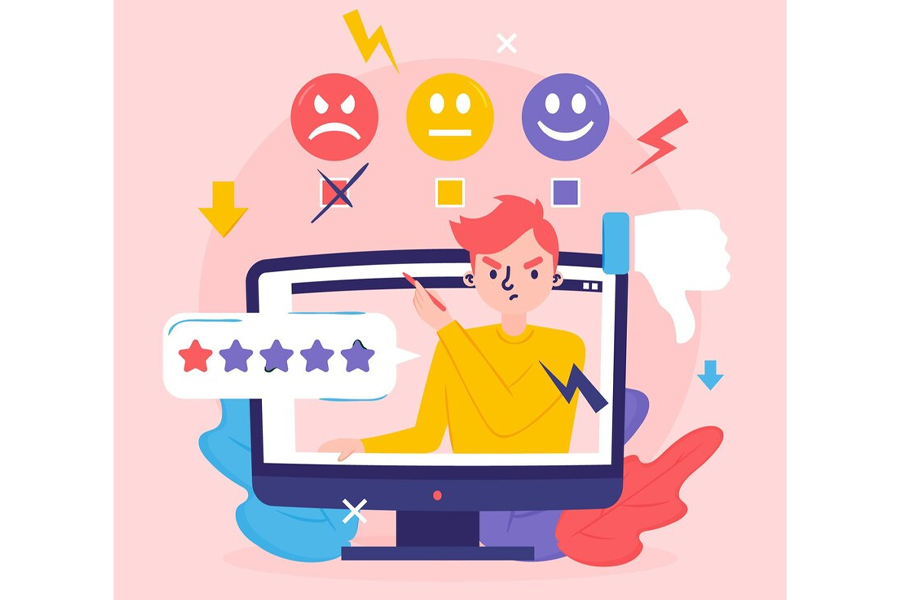
Have you encountered a difficult customer? As you reflect on those times, how would you have handled it? Do you have set protocols? Do you think they’re important?
How do you, as a business owner, handle difficult customers?
This article will guide you in the complexities of trying human behavior, and guide you to effectively communicating with them for business growth and success. Transform customer bungles into customer loyalty by reading through our tips and advice.
Understanding Difficult Customers
Satisfying your customer’s needs is one of the essential ways to bolster your business’s sales and growth. But it’s not always easy.
A business owner will always have to handle difficult customers. The outcome of how you or your service team treats them can either break or make your business.
So, how do we handle them? To answer this, let’s first define what ‘difficult’ customers are.
Definition and common types of difficult customers
Difficult customers are people who exhibit difficult behaviors, communication styles, or expectations for your employees. They give your people a hard time – but more than that, they might even drag your name into murky waters when they spread misinformation.
Common types of difficult customers include:
- Demanding customers: A demanding customer expects immediate attention and solutions. They are rude, verbally abusive customers. They are often hot-tempered, use loud tones, and are unreasonable on your employees.
- Complaining customers: Always finds fault, exaggerates problems, and focuses on insignificant details. They are very persistent in their complaints.
- Confused customers: They struggle to make a decision and change their mind frequently. They ask repetitive questions and may delay the whole sales process.
- Impatient customers: An impatient customer expects instant response and solutions and does not respect wait times. They interrupt or speak over employees just to get their point across, and easily get frustrated. Impatient customers also express their dissatisfaction loudly.
- Unresponsive customers: Some customers do not provide complete information. They are also often vague, and their body language sometimes causes miscommunication. Like confused customers, they delay the sales process.
- Know-it-alls: Belittles your employees and believes they have superior knowledge. They make it hard to communicate because they argue and dominate the conversation.
As a business, you can also encounter rude customers and indecisive customer groups, which will require different soft skills to speak and work with.
Keep in mind that these classifications are just generalizations, and one difficult customer can exhibit multiple types at the same time. It’s critical to know these types of customers because knowing is the first step towards addressing their needs.
The impact of difficult customers on businesses
What can a few bad apples do to a solid business? Unfortunately, their impact on businesses is significant. Financially, psychologically, and operationally, they have the potential to create far-reaching ripple effects.
Here is what can actually happen:
- They can cause damage to reputation and customer loyalty. An angry customer often shares their negative reviews through word of mouth or social media, and this attracts negative perceptions around the business.
- They sap your time and resources. These people require more from customer service reps when they have to deal with challenging customers, thus increasing operating costs for the business.
- They can make your employees feel bad. Terrible customers impact the well-being of employees. Negative interactions with people can be stressful. It affects their performance and job satisfaction, and can even lead them to feeling frustrated and quit.
Difficult customers don’t just feel bad to be around with, they also have a tangible impact for your business. These impacts should be recognized and categorized. Only can you start implementing effective de-escalation and management strategies in handling negative situations.

The importance of handling difficult customers effectively
We all know that it’s challenging. And we’ve all had thoughts of just disregarding them completely. But contrary to what you might initially think, every challenge has its benefits.
When you successfully turn negative experiences into positive resolutions, you can create remarkable results.
First of all, it encourages your staff. Being in a healthy workplace with set protocols for handling difficult customers will make them feel safe and protected. This, in turn, reduces the churn rate among your staff. On the operational side, your employees will feel equipped to handle difficult situations.
When they learn how to handle difficult customers, they get to hone important communication skills, customer service skills, and empathy.
It also encourages customers to share their satisfaction online.
It prevents tense situations from escalating into public complaints or even lawsuits. This attracts more potential customers, increases their trust, and builds a positive reputation.
Knowing what to do will help your customer service team reduce the time and effort they could have needed to de-escalate. At the same time, they get to build stronger relationships and collaboration within their respective teams when they successfully deal with difficult customers.

Best Practices for Dealing with Difficult Customers
Dealing with difficult customers is not a natural state. People don’t just instinctually respond positively to these stressful scenarios – they need training, or else they will fail miserably.
Your employees must be equipped and well-trained in dealing with difficult customers. In this section, we’re going to tackle some of the best ways to handle customers that might otherwise stress your team out, or even negatively impact your business.
Keeping calm and remaining professional
This is important for you and your employees’ well-being and the success of your business.
Don’t forget that their frustration is not personal. A frustrated customer is only frustrated at the situation, not at you, so don’t take whatever they throw at you.
View yourself as the facilitator helping to solve their problem.
Don’t react impulsively or mirror their aggression. Acknowledge their feelings but do not tolerate abusive behavior. Your communication style and body language should be assertive and professional to set clear boundaries.
An additional tip for you and your employees is to practice mindfulness or meditation techniques like deep breathing. These can help regulate emotions under pressure.
Listening to customers and showing empathy
Actively listening and showing empathy are important tools for dealing with difficult customers.
When a customer feels heard, it often reduces the frustration they are feeling. They are more likely to calm down and become more receptive to solutions.
Even if you disagree with their behavior, acknowledging their emotions shows that you care about their issues.
The way you practice active listening and show empathy demonstrates genuine interest in resolving the issue. This promotes trust and collaboration between you and the customer.
By this, it overall reduces the tension and you’re already in the process of de-escalating the situation.
Finding common ground and seeking solutions
When you express your desire to resolve the issue together with them, you shift the conversation from the conflict to a collaborative effort. This way, both your time is productive; moving towards seeking a solution.
Understanding the customer’s problem through common ground improves your understanding of the root cause of the problem. It lets you zoom in on specific pain points that fuel their frustration.
Brainstorming has benefits in creating the best solutions. When customers feel involved in crafting the solution, they’re more likely to accept and adhere to it, leading to better outcomes.
It strengthens customer relationship management.
Despite the initial difficulty, finding common ground and working together shows the customer you value their satisfaction. This fosters positive feelings towards your company, resulting in increased customer loyalty.
Setting boundaries and managing expectations
Setting clear boundaries and managing customer expectations should be made so that you will not have to compromise the well-being of your employees and the integrity of your business.
State what is acceptable and what is not in the interactions. Speak slowly, clearly, and confidently, both verbally and through written policies if needed. Consistently enforce it and do not tolerate any behavior that violates your boundaries.
When managing expectations, be realistic and honest. Explain what you can and cannot do to resolve the issue. Don’t make assumptions or promises you can’t keep.
Also, set clear timelines and be transparent about any potential delays.
Remember, setting boundaries and managing expectations is not about being rude or dismissive. It is for a safe and respectful environment for both your business and the customer.
Setting these strategies can effectively deal with upset customers while maintaining a positive and productive atmosphere.
Knowing when to escalate or disengage
While it’s always admirable to strive for a resolution, sometimes disengaging is the best course of action for both the safety and well-being of everyone involved.
When do you escalate? You escalate the issue when:
- Safety is compromised;
- Legal issues arise;
- They violate policies like being verbally abusive;
- Their frustration only intensifies despite best efforts to de-escalate;
- When there are significant impacts.
Remind them of the set boundaries and offer suggestions, like letting them speak with a supervisor or even scheduling a more convenient time to discuss the issue.
When do you disengage? It is time to disengage with them when:
- They start to harass;
- Engage in pointless arguments;
- It is beyond the employee’s authority;
- They start to emotionally manipulative;
- When the situation can’t be fixed.
By knowing when to escalate and disengage, your business protects your employees and ensures a positive and exceptional customer service experience.
Communication Strategies For Tense Situations
Being effective in communication is a skill that your employees need to master.
It’s an invaluable tool when dealing with potentially difficult customers, as effective communication is the foundation for all other de-escalation techniques. Without effective communication, your employees still can’t employ even the best strategies on earth.
This section will discuss everything you and your team need to know about communication strategies that will help you deal with difficult customers.
Effective communication techniques for handling difficult customers
Effective communication is a discipline. At its core, it’s empathizing with the other party while managing to get your point across. But like any discipline, it can be further subdivided into smaller techniques that make it easier for you to learn.
There are a lot of techniques you can work on, including the following.
- Active listening: Give your full attention to the customer, maintain eye contact, and understand their concern without interruption.
- Clarification: Clarify things to ensure you understand the whole thing. Repeat back what you have understood to confirm and demonstrate that you are actively listening.
- Validation: Validate their concerns and emotions to show that their feedback matters. Acknowledge their point of view and express empathy for their situation.
- Apology: Offer a genuine apology for any inconvenience or dissatisfaction they have experienced, regardless of who is at fault.
- Solution-oriented approach: Focus on creating practical solutions to address their concern and resolve it promptly.
- Follow-up: Follow up with them after the issue has been resolved to make sure they are satisfied and address any remaining concerns. This shows that your business is committed to customer care and helps build trust.
Using these effective communication techniques, you can effectively manage difficult customer interactions, resolve them correctly, and maintain positive customer experience.
How to deal with customers who are angry, upset, or irrational
Dealing with angry, upset, or irrational customers can be stressful. It takes a lot of courage for someone, especially if they’re non-confrontational, to engage with them. But, by learning the necessary knowledge and customer service skill set, situations like these can be managed.
The very first thing is to remain calm.
Take a deep breath, be composed, and don’t react emotionally to their behavior. Listen attentively, show empathy, set an even tone when speaking, and do not argue with angry customers. Apologize for any inconvenience they have experienced, and redirect the conversation towards finding a solution.
If they become abusive or inappropriate, calmly but firmly reiterate your boundaries.
How to use positive language and de-escalation techniques
Positive language refers to words and phrases that relay optimism, encouragement, and constructive intent in dealing with customers.
Meanwhile, de-escalation techniques are used to reduce tension and prevent conflict from escalating further.
Using positive language and de-escalation techniques go hand in hand when dealing with difficult customers.
In handling difficult customers, do the following:
- Use the words “we” and “us”. Instead of saying “You need to stay calm,” include them in creating a solution to foster collaboration and shared responsibility. For example, say “Let’s work together to find a solution.”
- Use positive framing. Tell them what you can do instead of what you can’t.
- Value your customers. Show that they are appreciated and important human beings. Phrases like “We value your feedback” or “Thank you for bringing this to our attention.”
- Use respectful language. Do not ever discriminate or be biased in your customer interaction.
- Use open-ended questions. Encourage them to elaborate on their needs by asking questions like “What can I do to help?”
- Offer choices and solutions. Present them with the available options. Ask for their input and tailor solutions to their specific needs.
Using positive language and de-escalation techniques creates a space for calm communication and lets you work towards a mutually beneficial solution.
Conflict Resolution Techniques To Try
It is important to establish a clear process for addressing complaints and concerns. This solves your customer’s issues while ensuring everyone’s safety and maintaining a positive environment.
This section will discuss healthy strategies for resolving conflicts. It will also tackle the importance of mutually beneficial solutions, and how to maintain positive relationships after resolving conflicts.
The importance of finding mutually beneficial solutions
When conflicts arise, a solution that satisfies the needs and interests of your business and the customer promotes cooperation, helps preserve relationships, reduces resentment, and enhances long-term success.
Mutually beneficial solutions often tap into diverse and creative solutions rather than one man trying to fix it.
When your customer feels their needs are addressed, there is a lesser chance of the issue resurfacing later. This saves time and resources in the long run. Forced solutions or repeated conflict resolution can be avoided when the solutions work for everyone.
Tips for maintaining a positive relationship with customers after conflicts have been resolved
After conflicts are resolved, express gratitude by thanking your customers for their patience. Acknowledge the time and effort they put into reaching a solution. Make your customer feel heard even after the storm passes.
Ensure all agreed-upon actions are promptly implemented. Make sure there are no misunderstandings and clarify if needed.
Offer a gesture of goodwill like a discount on their next purchase or a personalized thank-you note. This lets them know they are valued and that you take the importance of conflict resolutions.
Finally, train your team with conflict resolution skills and emphasize the importance of positive relationships with customers.
Be honest in your business, even when admitting mistakes. Use these opportunities to learn and improve communication.

Conflict Prevention Tips
Preventing conflict, of course, is better than resolving it after it occurs. It reduces costs and harm, ensures efficiency and productivity, and improves problem-solving and resilience.
Strategies for preventing difficult customer situations from occurring
Strategizing how to prevent difficult customer situations from occurring is important for maintaining high customer satisfaction and reducing the negative impacts of conflict.
By proactively addressing potential sources of friction, you can reduce the likelihood of difficult customer interactions and create an excellent customer service strategy.
Some steps to prevent difficult situations include:
- Streamline delivery process. Make sure your deliveries are accurate and arrive on time and keep your customers informed along the way.
- Ensure clear pricing and policies. Inform them of shipping fees, return policies, company policies, and other relevant things to manage customer expectations.
- Train employees. Your employees should know how to handle difficult customers. Emphasize educating them on empathy, active listening, and problem-solving skills.
- Monitor customer feedback. Identify pain points and areas for improvement by regularly gathering feedback from your customers.
- Improve communication channels. Make an easier way for your customers to express their questions or concerns, and prioritize prompt responses.
- Anticipate customer needs. As much as possible, identify patterns in their preferences and behavior.
While preventing all difficult situations is impossible, doing these strategies can decrease the number of conflicts, saving everyone time and effort.
Building strong customer relationships to prevent conflicts
One other way to prevent conflict is by having strong customer relationships.
To help you achieve this, build trust and transparency. Be honest, and don’t make promises you can’t keep. Showcase positive customer experiences.
Exceed their expectations. Go the extra mile, and offer solutions – not just empty apologies after a customer asks for them. Be flexible and accommodating.
More importantly, focus on understanding your customers. Acknowledging goes a long way.
Setting clear expectations and boundaries from the outset
Proactive communication starts with setting clear expectations and boundaries from the outset.
Make sure customers completely understand things regarding products, services, pricing, timelines, and any other important information. Document the agreed-upon expectation in writing, like contracts, service agreements, or terms of service.
Clearly define what is acceptable behavior in your business, your communication channels, response times, and scope of service, and reinforce your boundaries as needed to maintain a healthy and respectful relationship.
By setting clear expectations and boundaries from the outset, you can minimize misunderstandings and manage customer expectations effectively.
How To Ensure Self-Care and Well-Being In Your Team
Managing difficult customers can be emotionally draining and can lead to stress, frustration, and even burnout. This is why self-care is crucial for you, your employees, and anyone who interacts with the public regularly.
The importance of self-care in dealing with difficult customers
Having strong mental clarity is achievable when you take care of yourself physically and mentally. A strong mental clarity is very handy when they deal with difficult customers, it gives you a calmer and more positive attitude. Self-care also prevents burnout.
Self-care activities like exercise and relaxation techniques can help manage stress and build emotional resilience.
When dealing with difficult customers, self-care can take on the form of establishing firm boundaries or even disengaging from the conversation (while responsibly handing it to someone else with more bandwidth.)
When you take good care of yourself, you can think clearer, make better decisions, and be more patient, even in a tense situation.
Tips for managing stress and emotional reactions
When you get stressed, it manifests in physical symptoms like headaches, fatigue, and muscle tension. To avoid these, self-care activities like healthy eating, getting enough sleep, and regular exercise can significantly reduce the negative effects of stress.
When you prioritize self-care, you build stronger boundaries between work life and personal life. This allows you to not get affected by work stress. Mindfulness and relaxation techniques like deep breathing, meditation, or yoga can do the trick.
Take breaks for walks, stretches, or exercise to release pent-up energy and clear your mind. Spend time with loved ones and supportive friends who offer you encouragement and understanding.
Ultimately, surround yourself with positivity and do not indulge yourself in things that will stress you out more.
Strategies for maintaining a positive attitude and mindset
Cultivating a positive attitude and mindset can significantly impact your personal and professional life.
Here are several strategies to help you achieve this:
- Focus on gratitude. Write it down, express it, or reflect on positive experiences. Do anything that will make you focus on gratitude.
- Cultivate optimism. Challenge negative thoughts and focus on the good and positive outcomes.
- Connect with others. Do not surround yourself with negative people, nurture healthy connections and help others.
Consistently implementing these strategies and prioritizing self-care, everyone can develop a more resilient and optimistic outlook. This leads to a more productive and enjoyable work-life balance.

Training and Support
Training and support for employees who interact with many customers may be an expense, but it is a strategic investment in building positive relationships, reducing risks, and fostering a thriving business environment.
Tips for creating effective training programs
Creating effective training programs for dealing with difficult customer situations requires a lot of aspects to be addressed.
Here are some key points to consider:
- Needs assessment and content development. Identify the target audience and their specific challenges through past customer complaints, surveys, or employee input. Define clear learning objectives and develop engaging content tailored to different learning styles.
- Skill development and practice. Practice reflective listening, empathy, de-escalation techniques, communication skills, problem-solving, and product/service expertise through a combination of theoretical knowledge and practical exercises.
- Delivery and support. Choose appropriate training methods, involve experienced trainers, encourage active participation, and provide additional support and coaching to ensure knowledge retention and real-world application.
- Measurement and evaluation. Regularly assess the effectiveness of the training program through feedback, performance metrics, and customer satisfaction surveys to identify areas for improvement.
- Additional tips. Incorporate diversity and inclusion considerations, create a positive learning environment, recognize and reward success, and foster a culture of customer centricity throughout the organization.
By following these steps and continuously refining the training approach, you can equip employees with the necessary knowledge, skills, and confidence to effectively handle difficult customer situations.
Providing ongoing support and resources for employees dealing with difficult customers
The well-being, performance, and success of your business lie in providing ongoing support and resources for your employees.
A supporting environment means regular individual or group meetings and feedback with your employees to discuss challenges, share successes, and offer support.
Psychological safety is also important. Creating a safe space where they feel comfortable reporting difficult experiences without repercussions can greatly help them mentally. Empower them to make decisions and resolve customer issues without constant managerial approval.
Lastly, maintain a positive and supportive work environment that appreciates your employees’ efforts.
Having an ongoing support team is crucial for long-term success.
By implementing these strategies and tailoring them to your specific needs, you can create a supportive environment where employees feel equipped and empowered to deal with difficult customers with confidence, contributing to a more positive and productive workplace.
Frequently asked questions
Why is it important to address difficult customer situations in business?
Dealing with difficult customers is crucial for maintaining positive relationships, protecting reputation, and ensuring customer satisfaction, which ultimately contributes to business success.
What are some key learning objectives to include in a training program for handling difficult customers?
Some of the strategies that can have a significant impact include combining theoretical knowledge with practical exercises, role-playing scenarios for improving communication, case studies, and real-life examples to keep employees engaged and facilitate active learning.
What are some additional tips for effectively handling difficult customer situations?
It makes sense to incorporate diversity and inclusion considerations, create a positive learning environment, recognize and reward success among employees, and foster a culture of customer centricity throughout the organization.